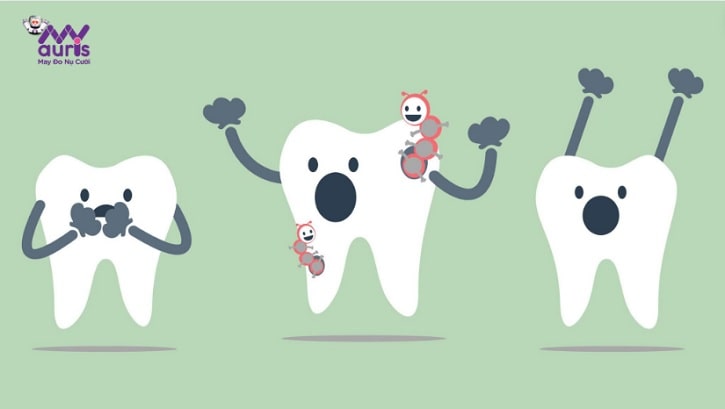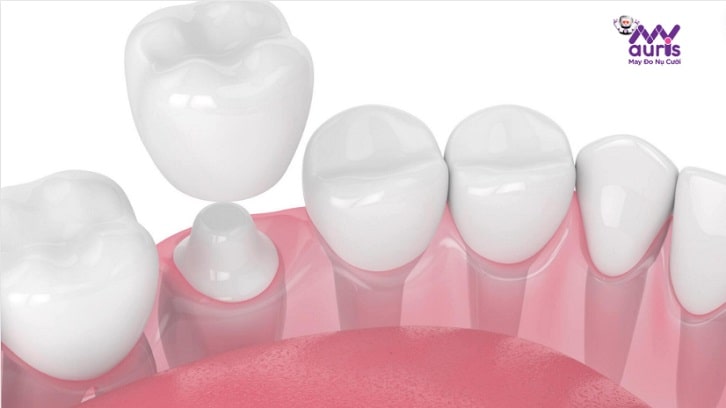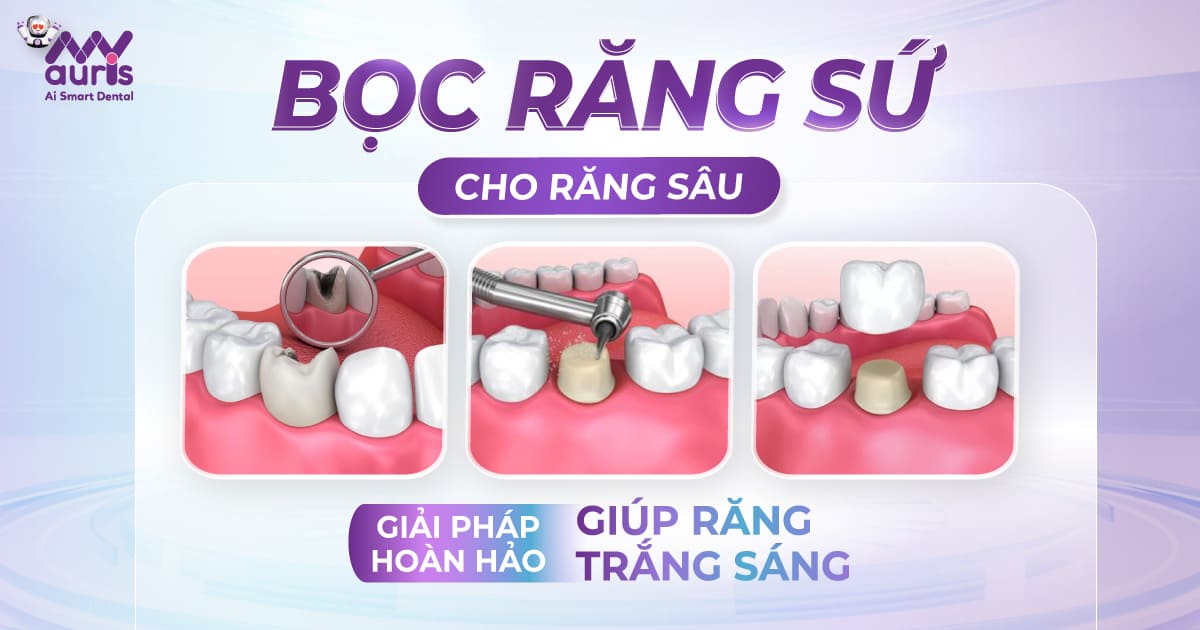Tooth decay often causes pain and discomfort, especially when eating and drinking. However, they are the cause of other dental diseases. Therefore, to fix quickly and bring high efficiency, many customers choose the method of porcelain crowns for cavities.
It is known that porcelain crowns are a commonly used cosmetic tooth restoration method today. Therefore, this article will explain in detail the advantages, disadvantages as well as the procedure when treating tooth decay.
What is tooth decay?
Tooth decay, also known as tooth decay, is when damage to the hard tissue of the tooth is caused by the process of mineral destruction. The cause is bacteria in plaque and small holes forming on the teeth. Furthermore, tooth decay is a combination of factors such as bacteria in the mouth, frequent snacking, using sugary drinks or improper oral hygiene.
In addition, tooth decay is one of the most common diseases, especially among children, teenagers and the elderly. However, anyone can have tooth decay (tooth decay), even newborns (due to genetic factors).
If tooth decay is not treated promptly, the condition will get worse and affect the real enamel layers. We will feel this most clearly when a toothache occurs, tiny holes appear on the tooth surface, the most serious is infection or even tooth loss. Therefore, we need to have regular dental check-ups at least every 6 months, and take care of our teeth by brushing and flossing to fight tooth decay that damages tooth enamel.

Causes of tooth decay that you need to know know
Tooth decay is because tooth decay is a process that occurs over a period of time. However, they will develop on their own and cause tooth decay due to the following common causes:
- Plaque: Plaque is a sticky film that covers teeth due to eating a lot of sugar and starch. When sugars and starches are not cleaned from tooth surfaces, bacteria will quickly begin to eat them and develop into plaque. This will cause plaque to harden below or above the gum line and form tartar.
- The acids in plaque remove minerals in hard tooth enamel: The first stage of tooth decay is the appearance of small holes or pits in the tooth enamel, a phenomenon called erosion. Once the tooth enamel is worn away, bacteria and acids can now penetrate the next layer of the tooth – called dentin. This layer is softer than enamel and less resistant to acids. Furthermore, dentin also has small tubes that come into direct contact with the tooth’s nerve and make the tooth more sensitive.
- As tooth decay develops, bacteria and acids continue to move through the tooth and pulp – which contains nerves and blood vessels. In case the pulp chamber is swollen and irritated from bacteria. Because there is no room for the swelling to expand inside the tooth, the nerve is compressed and causes pain.
However, the cause of tooth decay can be caused by some strains of bacteria that cause tooth decay in experimental studies, Streptococcus mutans.
Normally, when tooth decay occurs, the best and fastest treatment method is to apply tooth filling techniques. However, the tooth filling method is only applicable when the cavity is small (less than about 2mm). In some cases of severe tooth decay, this method is not effective and it is recommended to use the porcelain crown technique for cavities.
What is porcelain crown for cavities?
As we have learned the concepts and causes of tooth decay. Therefore, the best method up to now and ensuring the preservation of real teeth is the porcelain crown method.
To cover decayed teeth with porcelain, the doctor will grind the real teeth at a certain rate. Then put a porcelain crown on top to aesthetically enhance the jaw. If the tooth decay is severe, the doctor will perform root canal treatment and then proceed with the porcelain crown. However, when covering cavities with porcelain teeth for incisors or canines, you should choose all-ceramic teeth to avoid blackening of the gum line after a period of use.
However, one thing to keep in mind when applying the porcelain crown method is when the tooth roots are still strong. In cases where the tooth is loose, cannot keep the original tooth and is likely to spread tooth decay, extraction will often be indicated. Then, restore the lost teeth with removable dentures, porcelain bridges or implants.

Advantages of porcelain crowns for cavities
Porcelain dental crown method for cases with many cavitiesOutstanding features include:
Quick treatment time
The time to make porcelain teeth will depend on the condition of the teeth and the number of teeth needing treatment. In case of good oral health and 1-2 porcelain crowns, it can be completed in one day.
In case of dental diseases as well as a large number of porcelain crowns, the time can last from 2-3 sessions with a doctor’s appointment.
Restore chewing function
Porcelain crown technique can restore broken or broken teeth, cavities, pulp damage or discoloration, etc. After grinding the tooth, the doctor will cover the tooth with good quality and safe porcelain crowns. Thanks to that, customers can restore their original chewing function.
Ensuring aesthetics after treatment.
Porcelain crowns are highly appreciated for their aesthetics because each porcelain tooth is crafted according to tooth form, shape and size according to each preference and need. of each customer. Therefore, there will be a natural whiteness that is nothing compared to real teeth.
Disadvantages of porcelain crowns for cavities
Besides the While there are advantages of porcelain crowns for cavities, this method still has limitations (disadvantages) that you need to learn about before deciding to choose:
Invades real teeth. porcelain. However, if the doctor grinds teeth at the wrong rate, encroaching on the biological space, this will damage real teeth.
Accordingly, the biomineralization of teeth will be described as the total height of epithelial and connective tissue attachments, which will typically be about 2mm in size. If and only when the doctor determines the correct size of biominerals, can the tooth be grinded at the correct ratio. Not to mention, cases of excessive tooth grinding are the cause of potential risks such as infection, pain, sensitivity, etc.
Life expectancy is short and not high
The average lifespan of metal-ceramic teeth is 5-7 years and all-ceramic teeth last about 10 – 15 years. After that, during this time the customer needs to return to the dentist to have new teeth restored.

Process of porcelain crowns for cavities
The process of porcelain crowns for cavities at My Auris dental clinic is performed by a team of doctors with expertise and extensive experience in the field of cosmetic porcelain crowns. Thanks to that, customers can rest assured to get restorations here and the steps below are performed. Show the sequence according to WTS (Way to Smile) standards:
Step 1: Examination and consultation
The first step, the doctor will conduct a dental health check as well as general health. This is also an important step to know if you can get porcelain crowns for your teeth deep or not.
After conducting the examination, the doctor will examine and objectively evaluate each specific case. If the case can be done, the doctor will advise on suitable types of porcelain teeth as well as restoration costs.
Step 2: Proceed with anesthesia and root grinding. teeth
Next step, the doctor will anesthetize the treatment area and clean the teeth (scaling). Then, grind the teeth at the correct ratio. Normally, the actual tooth pulp grinding ratio will be about 0.5 – 1 mm.
Step 3: Take the sample tooth impressions
After grinding the teeth, the doctor will take tooth impressions using modern tooth scanning technology. Next, the doctor will advise on the tooth shape and color to suit each customer’s needs and preferences.
Finally, the doctor All information will be sent to the Labo room to make suitable porcelain teeth.
Step 4: Fix the teeth
In the final step, the doctor will attach the porcelain teeth and check whether the bite and aesthetics are suitable or not. If suitable, the doctor will proceed to attach the porcelain teeth fix and finish the process of porcelain crowns for cavities.
The above are related content about porcelain crowns for cavities will help you get rid of concerns and worries before deciding to do it. To ensure effectiveness, you should choose a dental address reputable, has a team of good doctors like My Auris Dental to meet procedures performed properly and according to standards with advanced equipment.
Kim Dung





